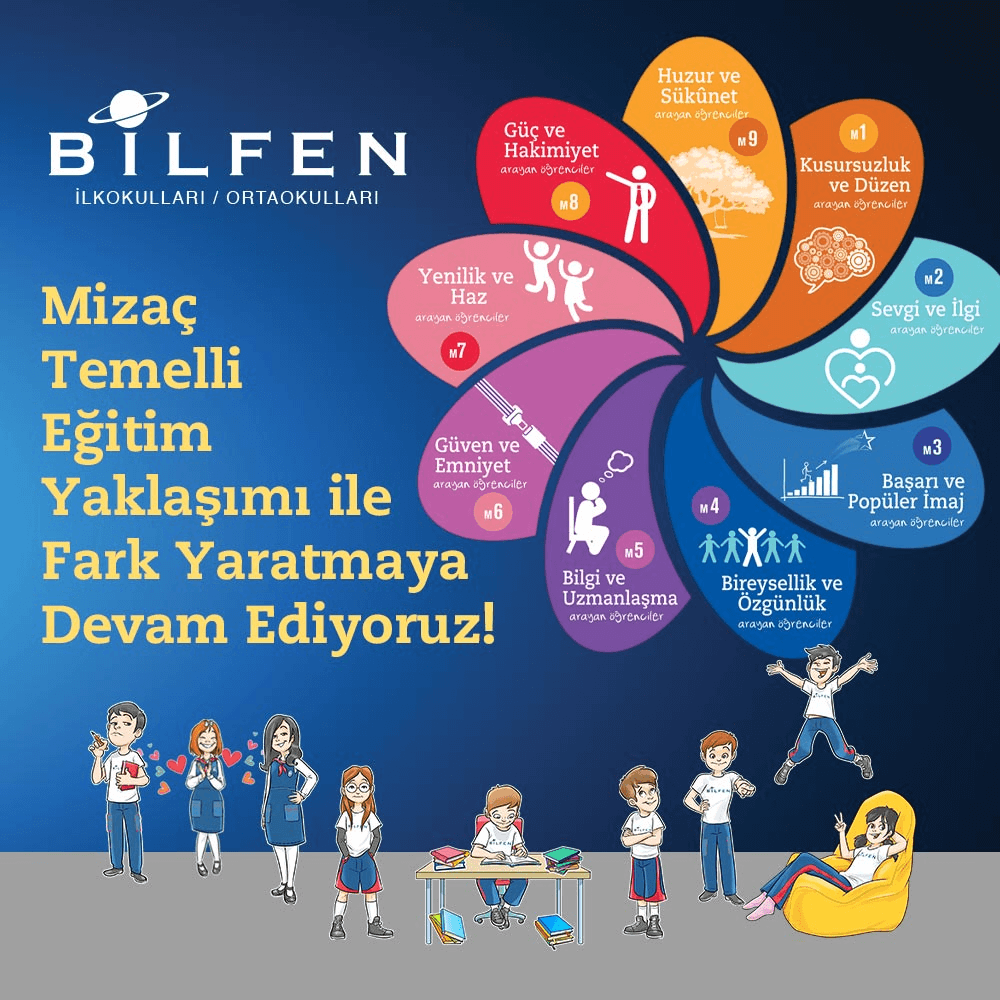
WE CONTINUE TO DISCOVER INDIVIDUAL DIFFERENCES THROUGH THE ENNEAGRAM OF PERSONALITY MODEL
Encouraging research and aiming to ensure intellectual and physical development in the education process, Bilfen Schools continue to discover their students’individual differences by means of the “Enneagram of Personality Model” which has been integrated into Bilfen’s education system since 2016 as the key to understanding differences.
Bilfen Schools place particular importance on students’ individual characteristics in education and it is through the “Enneagram of Personality Model” that Bilfen determines students’ basic motivations, strengths and weaknesses, and thus develop appropriate intervention methods. Identifying students’ personality types allows us to determine how students reason, how they learn more easily, what kind of a study environment they need, what they are motivated by, and how their motivation can be imroved. In this approach, the aim is to recognize and emphasize the potentially positive aspects of students’ personalities while minimizing the potentially risky characteristics. In the process, the personality types of students’ parents and teachers are also examined since these parties play an active role in students’ development.
The model consists of 9 core motivations that form the basis of personality and 9 personality types that correspond to these cores. Each of the 9 personality types is symbolised by a number. Each personality type has a fundamental motivation, need and pursuit. Every individual is born with one of these 9 personality types dominating their personality.
Here are the 9 personality types
M1: Perfection and Order Seekers: Enneagram M1 type individuals are generaly serious, solemn, measured perfectionists who are deliberate in their actions and words. In their pursuit of perfection, they try to do the right thing and be consistent and fair.
M2: Love and Interest Seekers: Enneagram M2 type individuals are generally loving and relationship-oriented people who act on their emotions.
M3: Success and Popularity Seekers: Enneagram M3 type individuals are generally self-confident, energetic people who are very keen on their image and appearance. They aspire to impress and evoke admiration in others.
M4: Individuality and Originality Seekers: Enneagram M4 type individuals are generally polite, naive people who place importance on originality and individual difference. They have a rich imagination and emotional world.
M5: Knowledge and Specialisation Seekers: Enneagram M5 type individuals are generally introverted, quiet and distant people who like to be alone, preoccupied with their thoughts. They can be shy about establishing relationships with others.
M6: Safety and Security Seekers: Enneagram M6 type individuals are generally calm people who are keen on getting along peacefully with others. They are mindful of their duties and responsibilities and are reasonable, calculated and controlled in their behavior.
M7: New Experience and Pleasure Seekers: Enneagram M7 type individuals are generally extroverted, cheerful, fun and active people. They make a point of enjoying life. They are witty and humorous.
M8: Power and Dominance Seekers: Enneagram M8 type individuals are generally brave, self-confident, assertive, protective and possessive. They are natural leaders who are very keen on their independence and hate to stand in the shadows.
M9: Peace and Quiet Seekers: Enneagram M9 type individuals are generally well-adjusted, calm, respectful, cool-tempered, peaceful and mediating people who dislike tension and unease.
How does knowing a student’s personality type help?
If you know your student’s personality type, you can understand his/her potential positive characteristics and thus support him/her by creating an appropriate environment for him/her to exhibit those positive characteristics. Or you can implement proactive activities to address student’s potentially negative characteristics, thus significantly preventing him/her from displaying such negative characteristics to the extreme.
Why adopt an enneagram-based educational approach?
The modern understanding of education dwells on the importance of educational practices that determine students’ individual differences and bring out their potentials in order to develop students as happy, healthy, productive, well-adapted, and socially responsible individuals. The Personality Type-based Educational Approach enables us to determine our students’ individual differences – and accordingly develop appropriate educational and pastoral approaches - based on the concept that personality characteristics are innate and do not change throughout one’s life, determining an individual’s perception, motivation and perspective.
The educational approach based on the Enneagram of Personality argues that the key parameter that determines individual differences is “an individual’s personality type which defines the main underlying reason for an individual’s main motivations and behaviors in life; organizes the whole operational, emotional, and intellectual structure; and forms the touchstone of an individual’s personality”. With personality types at its center, this approach enables us to determine each student’s “perceived priorities, psychological needs, motivations, talents, interests, and tendencies as well as his/her potentially risky characteristics”.
Can someone’s personality type change?
If we compare a seed to a student’s personality type and a newly blooming branch to a student’s personality; the image of a whole tree with its branches and leaves changing every season would compare to the student’s personality. Although personality type does not change throughout one’s life, changes in the reflections of personality can be observed just like the leaves of a tree that change and renew every season. Furthermore, with the influence of the education that a student gets in his/her family and in school, s/he can display some of the characteristics that are not prevalent in his/her personality type. We cannot change a student’s personality type, but we can significantly affect a a personality type to develop healthy or unhealthy characteristics.
Which one is the best personality type?
Although the personality types are ordered numerically, this method of ordering does not imply a difference in importance or usefulness. None of the personality types is better or worse than the others. Each personality type carries some potentially positive and potentially risky characteristics and theese characteristics can be advantageous in some situations and disadvantageous in others.





